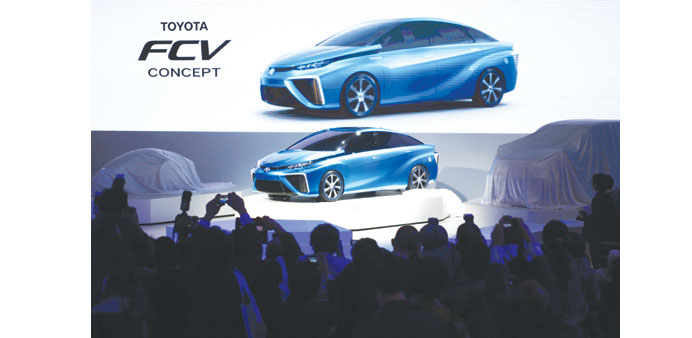Toyota Motor’s Fuel Cell Vehicle concept car is seen at the 43rd Tokyo Motor Show. Japan is readying subsidies to help the auto major and key suppliers take the lead in hydrogen-powered fuel cell vehicles.
Reuters/Tokyo
Japan is readying subsidies to help Toyota Motor and key suppliers take the lead in hydrogen-powered fuel cell vehicles that could top $400mn over the next several years if the most bullish projections for the technology play out.
Prime Minister Shinzo Abe’s planned consumer rebates of at least $20,000 per vehicle would be the largest government support plan for hydrogen vehicles yet, raising the stakes for a commercially unproven technology with roots in the space race that Toyota and others see headed for the mainstream over the coming decades.
The taxpayer-funded programme would bring down the cost of Toyota’s soon-to-be-launched hydrogen-powered fuel cell car to around $50,000 in Japan, about the cost of a small luxury sedan such as the BMW 3 Series.
Abe announced the outline of the plan last week and details are still being finalised.
The cost savings could be enough to make the Toyota vehicle affordable for taxi operators and other companies with fleets of vehicles within driving range of the 100 hydrogen fuelling stations that Japan expects to have built by March 2015.
“It’s still difficult to make these cars popular among ordinary consumers, but the subsidy has certain effects on companies interested in promoting themselves as green,” said Tomohide Kazama, Senior Consultant at Nomura Research Institute. “It’s a move to plant a seed for future growth.”
Fuel cell vehicles, which run on electricity made by cells that combine hydrogen and oxygen, have been in testing since the 1960s, when the technology was also being developed by NASA.
Since the vehicles emit only water and heat, they have been seen as an environmentally friendly alternative to those powered by combustion engines.
It could also help Japan shift to hydrogen energy as the country, dependent on imported fossil fuel as an energy source after the 2011 Fukushima nuclear disaster, seeks to cut carbon emissions. While much of the hydrogen used in the country now is made from fossil fuel, the government hopes to implement carbon-free production by 2040.
Promoting the technology last week, a smiling Abe test-drove Toyota’s fuel cell sedan, set to go on sale in Japan by end-March, and fuelled hydrogen into a Honda Motor Co FCX Clarity car, currently leased to governments and some companies.
The challenges to commercial use of fuel cell cars have been the lack of a hydrogen fuelling infrastructure and their high cost. Abe’s government has taken aim at both barriers in the hope of protecting an area of emerging technology where automakers and suppliers believe they have a lead over rivals in the US and Europe.
The $20,000 rebate per car means taxpayers may support subsidies of up to around $200mn a year. Annual sales forecast for fuel cell vehicles in the early years of market introduction vary from several hundred to 10,000 vehicles.
To put 100 hydrogen fuel stations in urban areas by end-March 2015, the ruling party has suggested a subsidy of up to $2mn per station – which cost $4-5mn each to build – meaning another $200mn in taxpayer money.
The government plans to continue offering subsidies and tax breaks so that fuel cell cars can sell at around the same price as gas-electric hybrids in the 2020s.
“The subsidy is a huge driving force for sales, but it won’t be offered forever and I think the message here is that we need to continue cutting costs,” said Koichi Kojima, a senior Toyota engineer who has been involved in fuel cell vehicle development for a decade.

